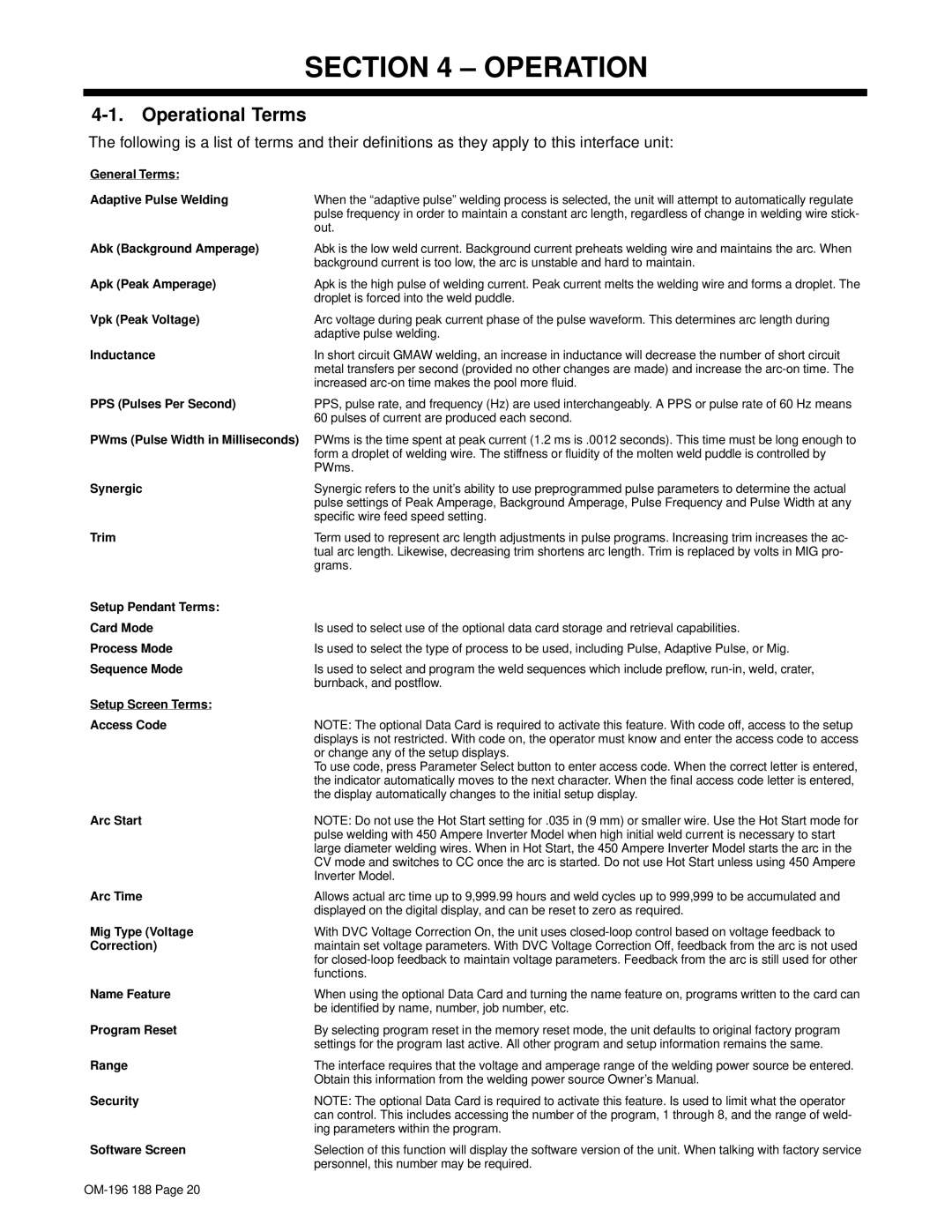SECTION 4 – OPERATION
4-1. Operational Terms
The following is a list of terms and their definitions as they apply to this interface unit:
General Terms: |
|
Adaptive Pulse Welding | When the “adaptive pulse” welding process is selected, the unit will attempt to automatically regulate |
| pulse frequency in order to maintain a constant arc length, regardless of change in welding wire stick- |
| out. |
Abk (Background Amperage) | Abk is the low weld current. Background current preheats welding wire and maintains the arc. When |
| background current is too low, the arc is unstable and hard to maintain. |
Apk (Peak Amperage) | Apk is the high pulse of welding current. Peak current melts the welding wire and forms a droplet. The |
| droplet is forced into the weld puddle. |
Vpk (Peak Voltage) | Arc voltage during peak current phase of the pulse waveform. This determines arc length during |
| adaptive pulse welding. |
Inductance | In short circuit GMAW welding, an increase in inductance will decrease the number of short circuit |
| metal transfers per second (provided no other changes are made) and increase the |
| increased |
PPS (Pulses Per Second) | PPS, pulse rate, and frequency (Hz) are used interchangeably. A PPS or pulse rate of 60 Hz means |
| 60 pulses of current are produced each second. |
PWms (Pulse Width in Milliseconds) | PWms is the time spent at peak current (1.2 ms is .0012 seconds). This time must be long enough to |
| form a droplet of welding wire. The stiffness or fluidity of the molten weld puddle is controlled by |
| PWms. |
Synergic | Synergic refers to the unit’s ability to use preprogrammed pulse parameters to determine the actual |
| pulse settings of Peak Amperage, Background Amperage, Pulse Frequency and Pulse Width at any |
| specific wire feed speed setting. |
Trim | Term used to represent arc length adjustments in pulse programs. Increasing trim increases the ac- |
| tual arc length. Likewise, decreasing trim shortens arc length. Trim is replaced by volts in MIG pro- |
| grams. |
Setup Pendant Terms: |
|
Card Mode | Is used to select use of the optional data card storage and retrieval capabilities. |
Process Mode | Is used to select the type of process to be used, including Pulse, Adaptive Pulse, or Mig. |
Sequence Mode | Is used to select and program the weld sequences which include preflow, |
| burnback, and postflow. |
Setup Screen Terms: |
|
Access Code | NOTE: The optional Data Card is required to activate this feature. With code off, access to the setup |
| displays is not restricted. With code on, the operator must know and enter the access code to access |
| or change any of the setup displays. |
| To use code, press Parameter Select button to enter access code. When the correct letter is entered, |
| the indicator automatically moves to the next character. When the final access code letter is entered, |
| the display automatically changes to the initial setup display. |
Arc Start | NOTE: Do not use the Hot Start setting for .035 in (9 mm) or smaller wire. Use the Hot Start mode for |
| pulse welding with 450 Ampere Inverter Model when high initial weld current is necessary to start |
| large diameter welding wires. When in Hot Start, the 450 Ampere Inverter Model starts the arc in the |
| CV mode and switches to CC once the arc is started. Do not use Hot Start unless using 450 Ampere |
| Inverter Model. |
Arc Time | Allows actual arc time up to 9,999.99 hours and weld cycles up to 999,999 to be accumulated and |
| displayed on the digital display, and can be reset to zero as required. |
Mig Type (Voltage | With DVC Voltage Correction On, the unit uses |
Correction) | maintain set voltage parameters. With DVC Voltage Correction Off, feedback from the arc is not used |
| for |
| functions. |
Name Feature | When using the optional Data Card and turning the name feature on, programs written to the card can |
| be identified by name, number, job number, etc. |
Program Reset | By selecting program reset in the memory reset mode, the unit defaults to original factory program |
| settings for the program last active. All other program and setup information remains the same. |
Range | The interface requires that the voltage and amperage range of the welding power source be entered. |
| Obtain this information from the welding power source Owner’s Manual. |
Security | NOTE: The optional Data Card is required to activate this feature. Is used to limit what the operator |
| can control. This includes accessing the number of the program, 1 through 8, and the range of weld- |
| ing parameters within the program. |
Software Screen | Selection of this function will display the software version of the unit. When talking with factory service |
| personnel, this number may be required. |
|
